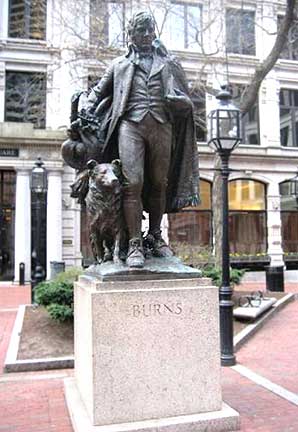
Most of us may not know the work of Robert Burns beyond his most famous composition sung every December 31st, Auld Lang Syne,” but Border Collie-owning fans of the poet know that he wrote, “The Twa Dogs” as partial tribute to his dog, “Luath.” The poem, written by Burns was he only 26 years old, was composed out of grief when his dog was killed while wandering. According to Gilbert Burns, Robert’s brother, Luath had been killed by the “wanton cruelty of some person.”
The tither was a ploughman’s collie-
A rhyming, ranting, raving billie,
Wha for his friend an’ comrade had him,
And in freak had Luath ca’d him,
After some dog in Highland Sang,
Was made lang syne,-Lord knows how lang.
He was a gash an’ faithfu’ tyke,
As ever lap a sheugh or dyke.
His honest, sonsie, baws’nt face
Aye gat him friends in ilka place;
His breast was white, his touzie back
Weel clad wi’ coat o’ glossy black;
His gawsie tail, wi’ upward curl,
Hung owre his hurdie’s wi’ a swirl.
Luath (Gaelic for “swift or nimble”) and Burns were inseparable, and it’s said that the Border Collie even “had a paw” in the matchmaking of Burns and his wife, Jean Armour; according to legend, the two met when Luath tried to steal the laundry Jean was hanging, and the small incursion gave Burns just enough courage to approach her. The abiding love of a poet for his dog was remembered by the Burns Memorial Association of Boston, Massachusetts when it commissioned a statue of Luath at Burns’ side. That was the easy part.
The monument created by sculptor, Henry H. Kitson, initially got lost en route to New York and Boston, and languished for three weeks on a low-speed train track section. Then the location for statue was changed four times before the Commission finally decided to situate it on the Fenway in Boston, Massachusetts, Once there, few people of Scottish descent missed the dedication ceremony.
Several Scottish societies, as well as the forty member Highland Dress Association (Pipe and Drum) participated in the parade to its original location on the Fenway greenway, though the statue was eventually relocated to Winthrop Square in downtown Boston.
It is by no means the only statue commemorating the poet and his dog. Another one stands on Sturt Street in Ballarat, Victoria, Australia (this one rumored to be the first statue of any poet in that part of the world), and one was erected outside Greyfriars in Dumfries in Burns’ native Scotland.
